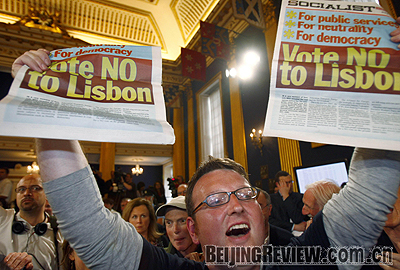|

IRISH SAY NO: An Irishman holding newspapers encouraging people to veto the Lisbon Treaty celebrates after the referendum’s result was released on June 13 in Dublin
In December 2007, the European Union (EU) issued the Lisbon Treaty as a replacement for the EU Constitution rejected by French and Dutch voters in 2005. The Lisbon Treaty retains the core of the EU Constitution, and seeks to reform EU structures as it opts for stronger leadership, unified foreign policy and a more equitable decision-making system. It was set to come into effect in 2009 and seen as a turning point for the EU as it steps out of its former constitutional crisis. But what was expected to be plain sailing has drifted into stormy seas.
To date, 26 of the 27 EU members have passed or plan to pass the treaty through parliamentary votes. Ireland, however, is the only country in the EU to hold a referendum on the treaty as required by its constitution. In the referendum on June 12, the Irish people vetoed the treaty with an objection rate of 53.4 percent, casting a shadow over the future of the European integration.
Why Irish rejection?
The main reason why the Irish people rejected the Lisbon Treaty was that they hoped to express their dissatisfaction with their government and the direction of European integration. First, the Irish worry that further enlargement of the EU will bring more immigrants from Eastern Europe, which will exacerbate the already small job market. The Irish economy is not in a good place, with the latest statistics showing a 10-year record high unemployment rate of 5.4 percent. Second, they were not pleased with some of the articles in the treaty. Some Irish believed that if the Lisbon Treaty goes into effect, the country's neutral diplomatic stance would be influenced, and the standard agricultural policy would reduce their advantage in this industry. They also believe there is a danger that they might be required to abolish the current abortion prohibition and lose their permanent European Commissioner title.
| 